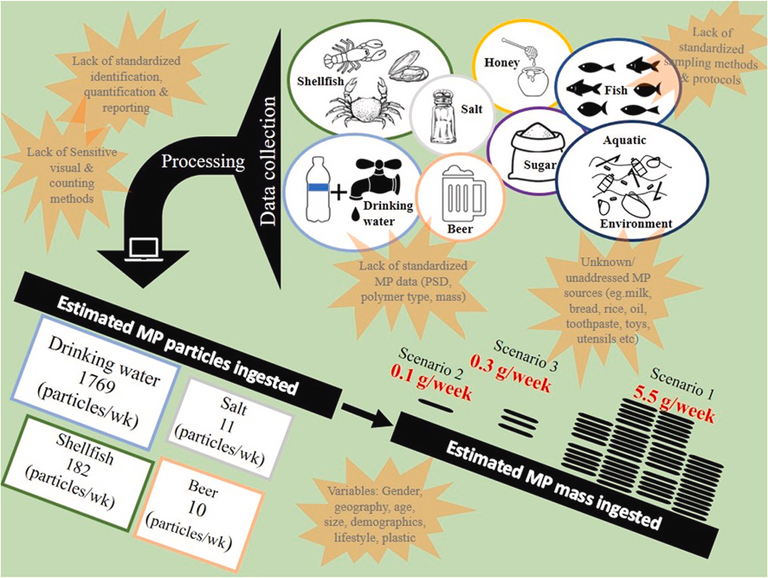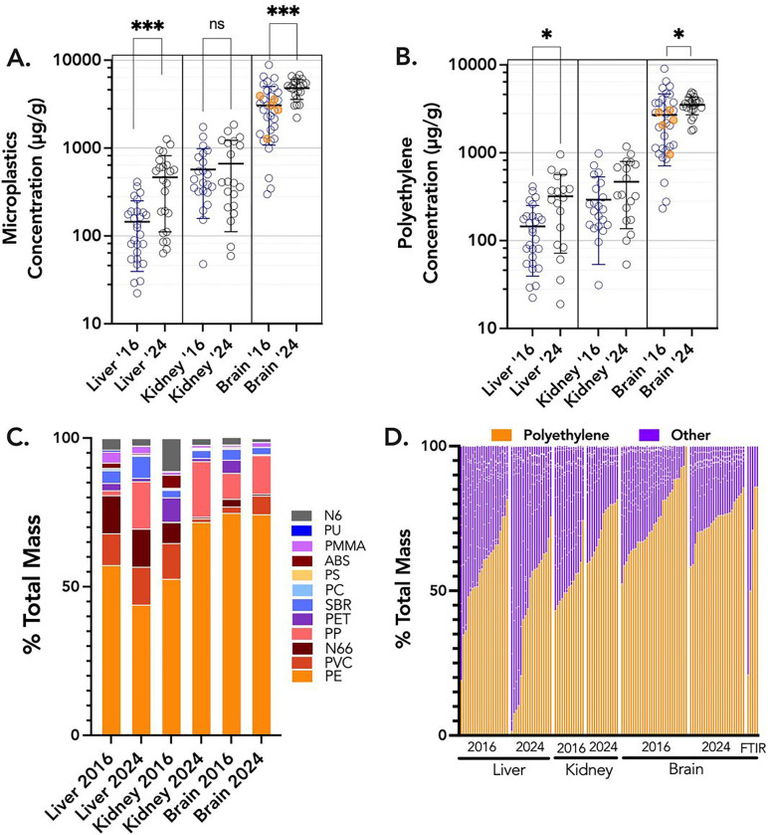0,5% of our brain mass is microplastic!
Steadily rising concentrations of environmental micro- and nanoplastics (MNPs) which land in our body (either directly or passed through the food chain) drive concerns for human health. MNPs are mostly polymer-derived (by degradation) particulates ranging from 500 micrometers in diameter down to 1 nanometer.
The extent to which microplastics cause harm or toxicity is unclear, but should not be underestimated(1). Numerous studies link MNPs to various hazards like reduced fertility, cancer and dementia. Moreover, the amount of microplastics exposure to humans is not well defined, making the human health risk assessment even more difficult.
In a recent study pre-print(2) by Campen at al., autopsy brain, livers and kidney samples from 50 deceased persons from Albuquerque, NM, collected in 2016 and in 2024 showed that all organs exhibited significant increases in MNPs from 2016 to 2024. In the study, pyrolysis gas chromatography-mass spectrometry was used to identify MNPs, a relatively new method that seems to be superior over purely microscopic evaluations that are mostly done so far and which can´t detect much of the small nanoplastic (<5 nm).
The brain samples (all from the frontal cortex) revealed much higher concentrations than liver or kidney, at 3057 μg/g in 2016 samples and 4806 μg/g (i.e. 0.48% by weight!) in 2024 samples, an increase of app. 50% over the 8 years! Polyethylene (PE) was found to be the predominant polymer in all tissues.
Why so much in the brain? The authors reason that the human brain has the second highest lipid content in the body (after adipose tissue) and MNPs are lipophilic and can easily pass the blood-brain barrier. Carotid plaques, which are also a lipid depot, had similar MNP-levels, as was shown by an earlier study.
It is not known if the MNPs in the brain accumulate lifelong or if they can get cleared as well. The lack of correlation with the decedent age suggests that an equilibrium occurs and that presumably dietary and lifestyle factors contribute to the between-subject variability in MNP concentrations. From a zebrafish study(3) we know that after constant exposure to polystyrene nanoplastics, uptake increased to a stable plateau whereby the maximal concentrations were increased proportionately with higher exposure concentrations.
Most alarmingly, the 12 brain samples from people who had died with dementia, including Alzheimer’s disease contained up to 10 times more plastic by weight than samples without an apparent brain damage(4) leading to the conclusion that excess amount of MNPs in the brain may facilitate dementia.

src
Since the introduction of plastic in the 1950s the global production of plastics is rising every year. The persistent mismanagement of plastic waste leads to a constantly increasing accumulation of micro- and nanoplastics in the environment and thus finally in our bodies through various exposure pathways. Even worse, microplastics are often associated with additives, heavy metals, pharmaceuticals, pesticides and various other organic pollutants. In a metanalysis from 2021(5) it was estimated that globally on average, humans may ingest 0.1–5 g of microplastics weekly!

src
When will mankind react? When 1% of our brain contains microplastic? 5%?
Apparently currently this is not in focus. All eyes are on the "evil" CO2...
What you can do?
- Prefer fresh food to plastic-wrapped and/or highly processed food
- Avoid plastic-bottled water (and soft drinks)
- Heat increases degradation of plastics, so avoid drinking hot beverages in plastic-lined throw-away cups, bring your own (stainless steel) mug instead
- Avoid heating plastic containers in (microwave) ovens, use glass or ceramic vessels instead
- Get rid of your non-stick/teflon pans, plastic cutting boards and plastic food jars
- Avoid tea bags, drink loose-leaf tea instead
- To reduce microplastic shedding from your clothes, wash them less frequently, prefer natural to synthetic clothing materials like polyester and nylon
- More tips here
Sources:
(1) https://www.sciencedirect.com/science/article/abs/pii/S0301479724000252
(2) https://pmc.ncbi.nlm.nih.gov/articles/PMC12003191/
(3) https://pubmed.ncbi.nlm.nih.gov/37321508/
(4) https://www.theguardian.com/environment/article/2024/aug/21/microplastics-brain-pollution-health
(5) https://www.sciencedirect.com/science/article/abs/pii/S0304389420319944

While we are concerned about the calories intake this is more harmful hhehe! WEll probably I have so many microplastics in my brain already...
good information!
Let us hope that this does not degenerate into a competition between man and fish. After all, it is in our 'nature' to devote ourselves to such things with all our might, only to be crowned the winner at a later date. 😮
In such a scenario, there is no chance for a rethink or for thoughtful action. The next generation will be born with a PET screw cap on the back of their head.🤫🥳
Hoffentlich artet dies nicht zu einem Wettbewerb zwischen Mensch und Fisch aus. Es liegt nämlich in unserer »Natur«, sich solchen Dingen mit Vehemenz zu widmen, um nur ja später zum Sieger gekürt zu werden.
In einem solchen Szenario hat das Umdenken und bedachtes Handeln keine Chance. Die übernächste Generation wird mit einem PET-Schraubverschluss am Hinterkopf geboren.
Finally! A possible explanation for all the craziness going on in the world all of a sudden. Can we find out whether MP is responsible for the rise of wokeness, suicidal empathy, and irrational fear of a breathing gas - all over the place at the same time? And more importantly, any ideas on how we get this crap out of our heads again? (the plastic AND the crazy ideas)
2 good questions!
How to excrete MNPs? Not much is known, probably by sweating and via the gut, so exercise a lot and eat fiber-rich diet.
Thanks for your contribution to the STEMsocial community. Feel free to join us on discord to get to know the rest of us!
Please consider delegating to the @stemsocial account (85% of the curation rewards are returned).
You may also include @stemsocial as a beneficiary of the rewards of this post to get a stronger support.
It is ironic that plastic drinking straws are forbidden, but just about everything else you buy in the supermarket is wrapped in plastic. I didn't know about Teflon, except the cheap pans are no good and easily scratch and flake off. But I do prefer cast iron skillets, it just takes time to properly clean a new one first, and then season it.